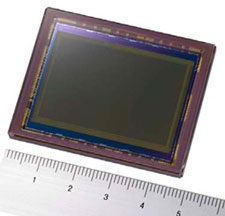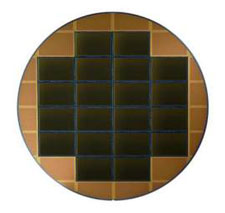(Update: Well yes, digital full-frame cameras do become part of mainstream, as the Nikon D600 and Sony RX1 suggest…)
Rumor has it that Canon does not just have any other digital full-frame camera on the horizon, as CanonRumors reports. According to CanonWatch the market leader will soon announce an entry-level full-frame camera with a price tag below $2,000, a 21MP sensor, weather sealed body and a simpler autofocus system than the one of it’s big brother, the EOS 5D Mark III. The 7D’s autofocus could do just fine…

It all makes sense.
But, market demand is one side. Moving up from cropped format to full-frame is not an easy choice for a photographer invested in APS-C cropped glass. Your DX lenses won’t cut it anymore if you’re not an admirer of corner light fall-off and heavy vignetting.
Feasibility is the other issue. Full-frame sensor production was prohibitively expensive only a few years ago.
Production costs for a full-frame sensor can still exceed 20 times the costs for an APS-C sensor.
Only 20 full-frame sensors would fit on an 200mm (8-inch) silicon wafer. Yield is comparatively low because the sensor’s large area makes it very vulnerable to contaminants. 20 evenly distributed defects could theoretically ruin an entire wafer. Additionally, the full-frame sensor requires three separate exposures during the photolithography stage, tripling the number of masks and exposure processes.

This economically advantageous, critical threshold may soon be reached.
Sensors are everywhere today. Prices have come down accordingly. Even the production of full-frame sensors with substantial faulty rejects due to contamination has become more feasible and therefore economically viable.
Amazon has the excelling Canon 5D Mark II for some $1,900 these days…
Big drawback remains the size of full-frame lenses. The trend is towards mirrorless compact system cameras. Canon and Nikon would produce a goose that lays golden eggs if they design a compact full-frame camera with good, affordable glass — or at least the most compact full-frame camera, an honor belonging to Leica for a long time.
Could it be that Canon’s entry-level full-frame has something to do with Canon’s mirrorless debut?
Entry-level full-frame will happen eventually, rather sooner than later. But what about the glass.
Full-frame lenses have their price tag; a fact that would reverse any cost advantage of an entry-level full-frame DSLR system. Or there goes the larger sensor’s IQ advantage.
It’s the good, costly glass that makes full-frame what it is.
Not to mention the size and weight of full-frame lenses – a dreaded nuisance to lug around. Full-frame is a thing of the past, old vs. new technology, symbol of size and virility vs. an interconnected society on the move, with the camera phone ready at all times. Big, heavy full-frame gear looks as fashionable as grandpa’s hat.
On the other hand, inexpensive lenses could be the very selling point of entry-level full-frame. It’s retro, it’s the real thing. If presented in a nice, compact package there could be a new winner segment in the camera market. Or how many mirrorless users are lamenting why no camera maker is squeezing a larger sensor in those bodies. They’d buy full-frame in a jiffy.
With full-frame you’re not only able to achieve more shallow depth of field, you’re finally able to use lenses at the focal length they’re designed for.
With cropped sensors photographers have to mess around with speciality lenses at F0.95 etc. With full-frame, even inexpensive lenses offer the bokeh you’re longing for when shooting APS-C or similar.
Add the lower pixel density, resulting in a lower sharpness requirement.
The main weaknesses of affordable full-frame lenses are size, weight and edge-to-edge sharpness — less of an issue for landscape photographers as they shoot at F11 to F16.
A portrait photog will love the inexpensive lenses as they’re sharp in the center.
Depending on your shooting style, entry-level full-frame might be the next thing.
Just shrink those lenses. The laws of physics allow only so much.
The key, one reckons, lies in in-camera processing, stupid!


